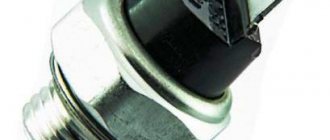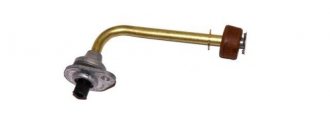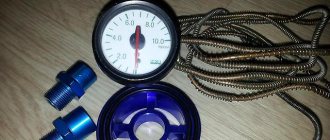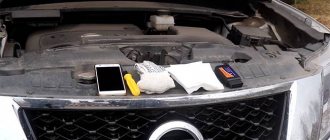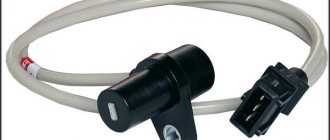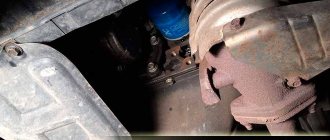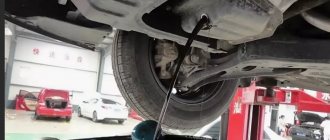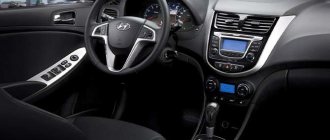Modern automotive industry is, first of all, technologies that will help the vehicle owner recognize a malfunction in time. The engine of a car is its “heart”. If the engine does not function normally, its elements will eventually become unusable, and then the components will have to be replaced.
Vehicles are equipped with an oil pressure sensor, which is an element of the oil system. Sometimes the meter is faulty, and then the device needs to be replaced. But before that, you need to know where the oil pressure sensor is located and what it is needed for.
Why do you need a device, its varieties
First, it is important to explain why an oil pressure sensor is needed. It is required to automatically measure the pressure of technical fluid, which is necessary to lubricate the main components of the engine. If there is not enough oil in the system, then irreversible changes will occur to the engine: the friction force of the cylinders and other moving parts will increase several times, which will lead to their further replacement.
Pressure sensors are divided into two types:
- Control. This is an electrical device that consists of a resistor and a converter. All information is transmitted to the ECU.
- Emergency oil pressure sensor. Installed on most vehicles. It shows the driver how much technical fluid is in the system. As a rule, the pressure is displayed on a dial indicator.
The principle of operation of an electronic and mechanical device
Before you learn how the oil pressure sensor works, you need to consider what elements it consists of.
Electronic controller circuit:
- filter;
- stub;
- pusher;
- pump drive;
- electrical terminals;
- indicator.
How does a mechanical controller work:
- stub;
- stock;
- spiral winding;
- dial indicator.
Operating principle of the electronic oil pressure sensor:
- After the motorist starts the vehicle, oil is supplied to the system.
- The oil filter pusher is automatically activated and the plug is displaced.
- The circuit opens and the signal goes to the oil sensor.
- The indicator lights up and informs the driver about the operating status of the system.
How does a mechanical oil pressure sensor work:
- Under pressure in the line, the plug begins to shift.
- Given the position of the plug, the rod moves and affects the dial indicator.
Pointer operation
On many old cars operating in the countries of the former USSR, devices were installed with an indicator of a specific lubricant pressure in the channels of the power unit. This circuit is not connected to the indicator, although it also represents a series of elements connected in series:
- oil sensor with rheostat;
- pointer device - pressure indicator;
- egnition lock;
- power supply.
The key element of the circuit is a rheostat pressure meter
. The sensor structure looks like this: inside the housing there is also a membrane with a pusher that moves the slider along the turns of a variable resistor - rheostat. How it works:
- When the ignition is on and the engine is not running, the resistance of the resistor is maximum, and the current in the electrical circuit is small. As a result, the needle of the electromagnetic indicator does not deviate from zero.
- After starting the power unit, the lubricant presses on the membrane, the pusher moves the slider several turns of the rheostat. The resistance of the element decreases, the current in the circuit increases and the arrow shows the pressure value at idle speed of the engine.
- In driving mode, the oil pressure moves the membrane and pusher as much as possible, and the resistance drops to a minimum. The arrow under the influence of current indicates the operating pressure.
The indicating device also uses a backlight, which is turned on together with the side lights.
The simultaneous operation of two systems - pointer and indicator - allows you to quickly identify a problem with one of the sensors. If the light suddenly comes on, but the arrow shows normal lubricant pressure, the driver can calmly go to the garage and figure out why the indicator is not working. A significant disadvantage of a sensor with a pointer is its large error, deviations reach 0.5–1 bar.
Location
The location of the oil pressure sensor depends on the design features of the vehicle. As a rule, the emergency controller is located on the cylinder head. You can find it at the radiator tap. A high pressure manifold is used to secure the device.
Modern cars may use two meters. The emergency lamp controller is installed before the bypass valve, and the second after the pressure reducing valve.
If you carry out a visual inspection, the sensor in the engine will look like this: the meter is installed in the cylinder head, and a black conductor approaches the connector. No other elements are provided.
Where is the oil pressure sensor located on different machines:
- VAZ 8, 9 and 10 series (8 valves). Finding it will not be difficult, just look at the main cylinder block. The controller will be located near the belt flap.
- VAZ-2110 and 2111 (16 valves). The car enthusiast needs to look at the camshaft. The measuring device will be installed directly on the block.
- Lada Kalina. You need to open the hood of the car and look at the main cylinder block. The measuring device will be mounted in a socket near the belt flap.
- Audi (model range until 2010). It is necessary to open the hood and pay attention to the oil filter, because the device is located there. The second oil temperature sensor will be located near the cylinder head.
- Chevrolet Lanos. You can find the controller by driving the car into a garage with a pit, since the device is built into the pump.
- Ford (model range until 2008). The vehicle owner needs to look under the front bumper, since the device is installed near the radiator.
- Mitsubishi Lancer. Oil pressure sensors are located near the filter and radiator.
- Nissan X-Trail. To locate the meter, you need to remove the right wheel and disconnect the belt flap. The device is located next to the power steering.
- Opel Astra. If you remove the right wheel, the device can be found near the generator.
- Volkswagen Golf. The car uses two devices at once. One is installed on the end of the cylinder head, and the other on the filter.
- Volkswagen Passat. This also uses two controllers. One is built into the filter, the other is located on the filter exhaust manifold.
- GAZ with engine ZMZ No. 405. Finding the controller is not difficult; just open the hood and look at the main cylinder block. The meter will be screwed directly into it.
Important nuances
- When removing the plastic cap from the oil sensor, extreme care should be taken.
The cap on the Daewoo oil sensor is made of very fragile plastic.
This part is held in place by two very fragile plastic latches that break easily, especially in cold weather. A seemingly insignificant cap can become a source of real headache for the driver, since it is almost impossible to find it on sale. This part is not sold individually. And you will only have to buy it together with a new spare part (and only on the condition that the purchased sample is equipped with its own wiring and cap, which is not always the case); - When unscrewing the sensor from the oil line socket, we must not forget about the copper o-ring, which is located under this device. If you remove the device without due care, the O-ring will fall off and fall straight into the crankcase. And to remove it, the crankcase will have to be completely dismantled;
The copper O-ring easily falls from the Daewoo car oil sensor into the engine crankcase - When removing the sensor, you should remember that there may be oil in the line behind it, and this lubricant may be under pressure. This means that some oil will inevitably leak out. Therefore, after the replacement, the driver must check the lubricant level in the engine. This is done with a special probe. And if the level is too low, you should add oil to the line to the required level;
- To prevent oil pouring from the engine from getting onto the garage floor, you should place some kind of container under the sensor hole. A small basin is ideal for this purpose;
When replacing the sensor, it is better to drain the engine oil into a small container - It is best to unscrew the sensor in Daewoo family cars not with an open-end wrench, but with a ring wrench, such as the one shown in the photo above. The location is such that it is almost impossible to unscrew it with an open-end wrench: there is very little space for this key (with one movement of the open-end wrench, the sensor can only be turned a third of a turn, so it is simply impossible to put such a key on it again);
- Sometimes the part cannot be unscrewed even with a convenient spanner due to the fact that it literally sticks to the oil line socket. It is categorically not recommended to make additional efforts in such a situation: the fragile device will simply break at the root. The threaded part will remain in the main socket. And it will be almost impossible to remove this fragment from the line without damaging the thread on the socket. The solution is simple: generously pour WD40 onto the welded part and wait 15 minutes.
Even a novice car enthusiast who has held a wrench in his hands at least once in his life can replace the sensor on a car from the Daewoo family. All it takes is 20 minutes of free time and a little patience.
Copywriter with five years of experience.
Signs of breakdown
Novice drivers can also determine if the sensor is broken. Typically, the on-board computer processes commands from all controllers and displays them on the screen. The corresponding indicators will also blink on the dashboard. If the system does not find any faults, the driver does not receive any warnings.
Signs:
- The car starts with difficulty, especially in the cold season.
- When the car owner starts the engine, it is worth paying attention to the blinking “Check Engine” indication, which indicates that the oil pressure is insufficient. It should also be noted that a similar signal may occur if oil with various types of impurities was used. It is necessary to carry out diagnostics to understand why the malfunction occurred.
- It is difficult to accelerate the engine to the required speed. Also, when the engine is running, excessive vibration may occur.
Signs and causes of malfunctions
The main signs indicating a malfunction in the oil pressure controller:
- The oiler indicator, along with the Check Engine light, lights up for a few seconds, and then, after starting the engine, flashes and goes out. The problem often appears when driving at idle speed.
- There were problems starting the power unit. If the engine runs out of lubricant, it will have difficulty turning the crankshaft.
- While driving, jerking appeared, this problem is especially obvious at low speeds.
- The power of the power unit decreases noticeably during acceleration.
- There may be problems with the ignition switch. The problem may be caused by poor quality power or a break in the wiring connected to the meter.
List of reasons why the meter may fail:
- One of the main reasons is the lack of lubricant level in the engine. It is important to regularly check the oil volume and add it if necessary. The sensor may leak as a result of mechanical damage or a defect in the cylinder block or crankcase.
- Oil pump failure. As a result of the fact that the device cannot pump liquid, problems arise in the operation of the engine. If the sensor is installed in the pump, the mechanism must be replaced.
- The measuring element is clogged with wear debris. The clogging problem can be resolved by cleaning the controller.
- Filter device clogged. If the mesh is clogged, the circulation of the lubricating fluid will be disrupted and the substance will not be able to pass through the filter.
- Failure of the meter membrane due to its damage. This problem causes the dashboard to display incorrect readings regarding the operation of the controller.
- A short circuit in the electrical circuits coming from the measuring device to the dashboard or on-board computer. This problem often occurs as a result of moisture getting into the power connector or deterioration of the insulation on the cable.
- Failure of the measuring controller relay or safety element due to a short circuit.
- Wear of the resistive layer of the device.
- Breakdown or malfunction of the heating component of the bimetallic plate.
- Residual deformation of bimetallic plates.
Video: signs of an oil can indicator on the dashboard
User Denis Ivanchuk in his video spoke in detail about the reasons associated with the blinking of the oil indicator light on the control panel.
Diagnostics of the electronic oil pressure sensor
You can check an electronic car sensor with a multimeter yourself like this:
- The tester is set to the mode of interruption or “continuity” of the power supply line and control of the controller. It is very important to ensure a good seal as this will determine the outcome of the test.
- One terminal of the tester is connected to the central output pin of the measuring device, the second goes to the case or ground. As a “ground” you can use any bolt screwed into the car body or the metal surface of the engine.
- Using a pump, pressure is applied to the controller, which should be approximately 1-1.5 atm. If exposure to air is strong, the membrane may be damaged.
- If the line is open, this indicates that the regulator is working; if not, the sensor must be replaced.
Instead of a tester for checking, it is allowed to use a light indicator, which is designed to operate under the influence of a voltage of 12 volts. To complete the task, you will need a power supply - a battery, as well as a compressor. It is advisable that the latter be equipped with a pressure gauge.
Diagnostic Guide:
- Two conductors are connected to the outputs of the light indicator.
- One of the cable contacts that goes to the indicator for testing must be connected to the output regulator of the measuring device.
- Then the ground terminal from the battery (negative contact) is connected to the regulator body.
- The other output on the indicator light is connected to the positive contact from the battery or other power source.
- If the measuring device is operational, after activating the battery or making contact with it, the light will light up. If this does not happen, then the measuring element is faulty and must be replaced.
- After this, for diagnostics you need to take a compressor and apply a pressure of about 0.5 atm to the membrane. The value of this parameter may vary, depending on what the controller is designed for. Very high pressure cannot be applied to the sensor’s sensitive element, as this will damage the membrane.
- When the operating pressure value increases to the specified parameter, which is critical for the meter, the indicator should turn off. This is due to the fact that the control power line will open in the regulator housing. If this does not happen, the controller must be replaced.
It is important to know
Instead of a compressor device, you can use a regular pump from a car or bicycle with a pressure gauge for diagnostics.
Mechanical DDM check
Diagnostics of mechanical meters is also carried out using a pressure gauge, but an electronic device is required.
Checking the mechanical DDM is carried out as follows:
- On the engine fluid pressure regulator, find the output that supplies the impulse for the emergency indicator light to the control panel. Before disconnecting the connector, clean the pins on the meter.
- Find the contact element from which the pulse comes to indicate the engine fluid pressure.
- Take a ground or ground for measurements from the body of the measuring device or from any metal surface under the hood.
- Connect the positive and negative power contacts, as well as the pulse from the meter (there are three contacts on the sensor).
- Then connect the air pipe from the pump or compressor device to the sensitive element (membrane).
- Apply 1-2 atmospheres of air to the meter. If the device is operational, the incoming pressure will be displayed on the dial pressure gauge. If the sensor is faulty, the arrow will not move.
Video: self-diagnosis of the oil pressure meter
User Igor Belov in his video spoke in detail about the procedure for checking the engine fluid pressure controller.
Why the meter may fail
Malfunctions of the oil pressure sensor are due to the following reasons:
- valves or pump diaphragm are damaged;
- deposits have formed on the walls of the pipe, which are caused by the accumulation of waste material;
- the motorist has not changed the oil for a long time;
- the filter is clogged with waste material;
- mechanical damage to the rod (it is because of this that there may be insufficient oil pressure);
- short circuit;
- Due to long-term operation, the main elements of the oil line have worn out.
Functionality check
Many novice car enthusiasts ask how to check the oil pressure sensor. Before starting the inspection, you should prepare the necessary tools and carry out the preparatory work:
- pressure gauge;
- pump;
- multimeter;
- hose.
Step-by-step instructions for checking an electronic device:
- Turn off the engine and give it time to cool.
- Set the multimeter to circuit testing mode. Connect the black probe directly to the controller, and ground the second one to the power plant housing.
- Connect the pump to the controller and secure it as much as possible so that there are no leaks. The results of the check will depend on this.
- After connecting the pump, release pressure to 1 atmosphere into the main line. The multimeter should show a shorted electrical circuit. If this does not happen, you should proceed to replacing the device.
Instructions for checking a mechanical device:
- Take a rubber hose of small diameter, connect one end to the pump and the other to the sensor.
- Carefully release the pressure to 1 atmosphere.
- The membrane should change its position, and the parameters should be displayed on the dial indicator.
If the arrow does not move, the device should be replaced.
Oil pressure sensor operation
There are two types of sensors installed on cars - the so-called old and new. Accordingly, the old ones are mounted on already outdated car models, for example, on VAZ “classics”, UAZs and other domestic cars of yesteryear. New ones are also installed on new VAZs, as well as other cars, both domestic and imported.
What is an oil pressure sensor used for?
The principle of why an oil pressure sensor is needed is quite simple. The task of any such sensor is to monitor the oil pressure value in the car’s oil system and detect if it exceeds the permissible limits, for which it transmits signals either directly to the warning lamp (old sensors) or to the electronic engine control unit (ECU). And he already conveys the relevant information to the driver in the manner provided for this (either using the same warning lamp on the parting panel or using a multifunctional monitor installed on modern “sophisticated” foreign cars).
How to check the oil pressure sensor
To check with your own hands whether the oil pressure sensor is working correctly, you will need a multimeter or a test light. The main way to check it is to measure the resistance, but you can verify its functionality with a pressure gauge Read more
Both sensors are built into the oil system, and the sensitive element is a mandatory part of them. This sensing element uses a membrane that bends under the influence of oil pressure. In older sensors, this mechanical bending is fixed using a rheostat (variable resistance resistor), and the absolute value of the voltage (potentiometer) is displayed on the pressure gauge, according to which the needle moves across the device, calibrated in absolute pressure units. Thus, the driver can visually monitor the pressure value in the car’s oil system.
Example of DDM location
The installation location of the “new” oil pressure sensors is similar. They are also built into the overall oil system, and are located somewhere in the area of the oil filter, in the cylinder block body, or in the cylinder head (cylinder head). Their sensitive element (membrane) is also built into the line and bends under the influence of the pressure present in it. However, their signal conversion mechanism is different. So, in the absence of pressure, the membrane stands straight, and the rod located on it does not rise and does not open the electrical circuit of the warning lamp on the dashboard (usually goes through the computer). Thus, in the absence or low pressure, the lamp is in the on state. When there is pressure in the line, the membrane bends, its rod goes up and mechanically opens the mentioned circuit. Thus, the control lamp goes out. Accordingly, when the pressure drops to its critical value, the circuit closes again and the lamp lights up.
Replacement instructions
If the oil pressure sensor in the engine is faulty, then do not hesitate; you must immediately buy a new element and begin replacing it. You can fix the problem yourself, without contacting specialized service centers. It is enough to have basic skills. Before starting work, you need to prepare the following tools:
- rags;
- silicone grease WD-40;
- key.
Step-by-step instruction:
- Turn off the engine and let it cool.
- Remove the car battery.
- Remove fasteners.
- If the sensor is stuck to the cylinder head, it needs to be treated with WD-40 lubricant.
- Remove the device from the mount using a suitable wrench.
- Carefully unscrew the sensor from the mounting hole.
- Clean the mounting hole from dirt, rust, sediment and lubricate it with engine oil.
- Place a sealed ring, screw in the new controller and tighten it tightly without any extra effort.
- Put the battery back.
- Start the engine.
After starting, you need to check if the Check Engine warning light is flashing.
Operation and care
To avoid malfunctions, you should adhere to the operating rules:
- periodically carry out preventive maintenance of the oil system;
- check the operation of the pump;
- clean the filter from waste materials;
- control the lubrication of power plant units;
- if the technical fluid has changed color, change it immediately;
- If the low pressure signal constantly sounds, immediately diagnose the vehicle yourself or contact a car service center.
It is recommended to use engine oil only from trusted companies and suitable for a specific vehicle model. In inexpensive technical fluids, there is an excessive amount of impurities that settle in the lines and cylinders. They disable the main elements of the engine. It is also recommended to change the engine oil after a mileage of 10 or 15 thousand kilometers. Therefore, it is worth reading the car’s service book to find out all the details of the operating rules.
To summarize, we can conclude that the oil controller is one of the main measuring instruments of a vehicle. If it is faulty, then over time the internal elements of the power plant will be damaged, and then you will have to spend a lot of money on repairing the car. You can carry out the replacement yourself, without contacting a service center.
